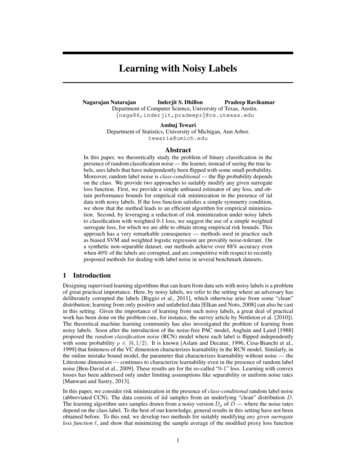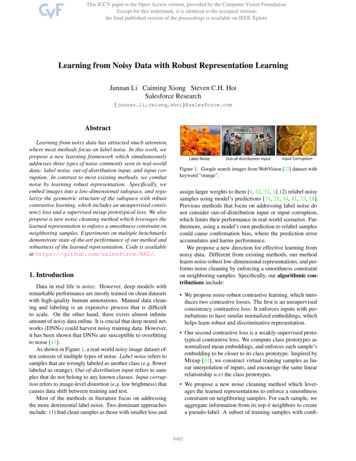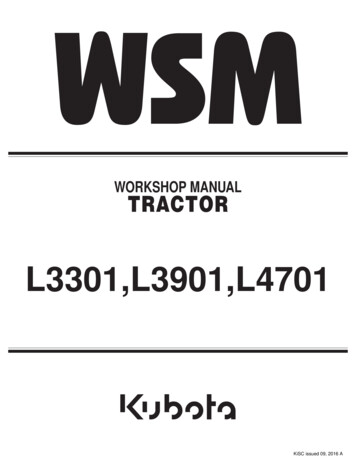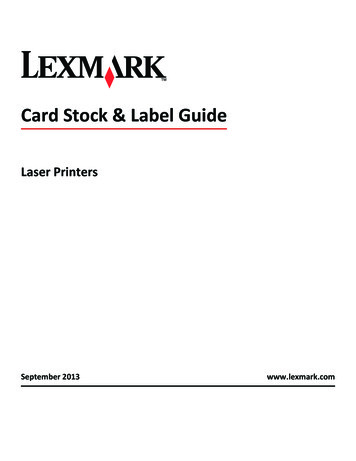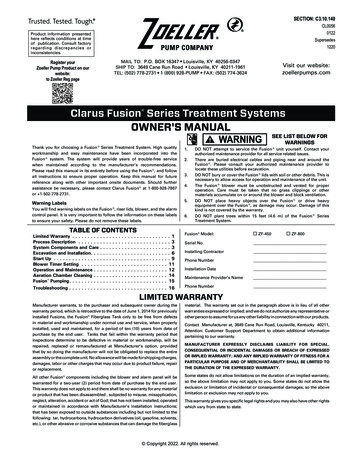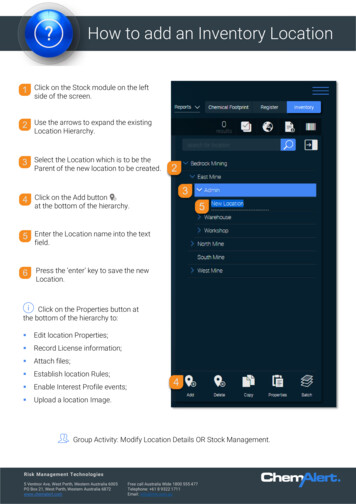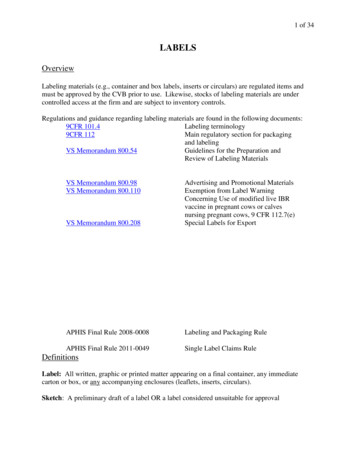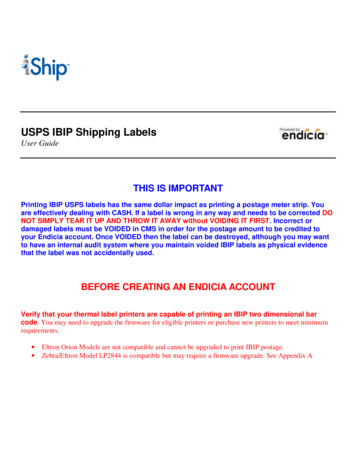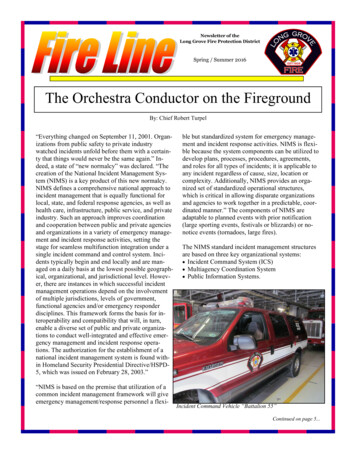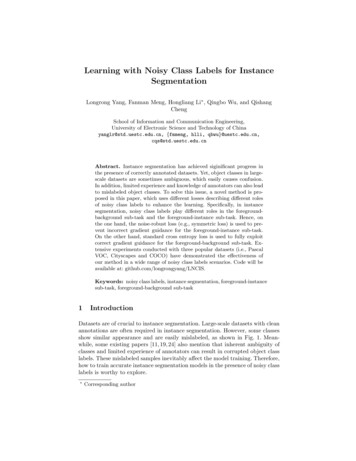
Transcription
Learning with Noisy Class Labels for InstanceSegmentationLongrong Yang, Fanman Meng, Hongliang Li , Qingbo Wu, and QishangChengSchool of Information and Communication Engineering,University of Electronic Science and Technology of Chinayanglr@std.uestc.edu.cn, {fmmeng, hlli, qbwu}@uestc.edu.cn,cqs@std.uestc.edu.cnAbstract. Instance segmentation has achieved siginificant progress inthe presence of correctly annotated datasets. Yet, object classes in largescale datasets are sometimes ambiguous, which easily causes confusion.In addition, limited experience and knowledge of annotators can also leadto mislabeled object classes. To solve this issue, a novel method is proposed in this paper, which uses different losses describing different rolesof noisy class labels to enhance the learning. Specifically, in instancesegmentation, noisy class labels play different roles in the foregroundbackground sub-task and the foreground-instance sub-task. Hence, onthe one hand, the noise-robust loss (e.g., symmetric loss) is used to prevent incorrect gradient guidance for the foreground-instance sub-task.On the other hand, standard cross entropy loss is used to fully exploitcorrect gradient guidance for the foreground-background sub-task. Extensive experiments conducted with three popular datasets (i.e., PascalVOC, Cityscapes and COCO) have demonstrated the effectiveness ofour method in a wide range of noisy class labels scenarios. Code will beavailable at: github.com/longrongyang/LNCIS.Keywords: noisy class labels, instance segmentation, foreground-instancesub-task, foreground-background sub-task1IntroductionDatasets are of crucial to instance segmentation. Large-scale datasets with cleanannotations are often required in instance segmentation. However, some classesshow similar appearance and are easily mislabeled, as shown in Fig. 1. Meanwhile, some existing papers [11, 19, 24] also mention that inherent ambiguity ofclasses and limited experience of annotators can result in corrupted object classlabels. These mislabeled samples inevitably affect the model training. Therefore,how to train accurate instance segmentation models in the presence of noisy classlabels is worthy to explore.?Corresponding author
2L. Yang et al.motorcycle(a) Image(b) Sample without Noisebicycle(c) Sample with NoiseFig. 1. Example of noisy samples in the instance segmentation task. This example isselected from Cityscapes dataset [5]. In this example, object class motocycle is mislabeled as class bicycle by the annotator. We mainly discuss the noise on object classlabels in this paper. Similar with methods in classification, datastes with lots of noiseare produced by artificially corrupting labels.In the classification task, label noise problem has been studied for a longtime. Some existing methods apply the noise-robust loss (e.g., symmetric loss)to all samples to reduce gradients generated by noisy samples, such as [8,29,33].These works have achieved promising results in the classification task. However, in the instance segmentation task, noisy class labels play different roles inthe foreground-background sub-task (i.e., distinguishing foreground and background) and the foreground-instance sub-task (i.e., classifying different classesof foreground instances). From the perspective of the foreground-backgroundsub-task, all class labels always provide correct guidance to the gradient update. Hence, if some key samples to the foreground-background sub-task aresuppressed by the noise-robust loss in the gradient computation, the foregroundbackground sub-task is inevitably degenerated.To solve this problem, we propose a novel method in this paper, which describes different roles of noisy class labels using diverse losses to enhance thelearning. Firstly, some evidences provided in [1, 21, 32] show that models proneto fit clean and noisy samples in early and mature stages of training, respectively.Hence, in early stages of training, the classification loss remains unchanged. Inmature stages of training, we observe that negative samples (i.e., samples belonging to background) are impossibly noisy and pesudo negative samples (i.e.,positive samples misclassified as background) play key role in the foregroundbackground sub-task. Hence, cross entropy loss is applied to all negative samplesand pesudo negative samples, to fully exploit correct gradient guidance providedby these samples for the foreground-background sub-task. Meanwhile, the noiserobust loss is applied to other samples for the foreground-instance sub-task. Inaddition, we also use loss values as the cue to detect and isolate some noisysamples, to further avoid the incorrect guidance provided by noisy class labelsfor the foreground-instance sub-task. This proposed method is verified on threewell-known datasets, namely Pascal VOC [7], Cityscapes [5] and COCO [19]. Ex-
Learning with Noisy Class Labels for Instance Segmentation3tensive experiments show that our method is effective in a wide range of noisyclass labels scenarios.2Related WorksLearning with noisy class labels for the classification task: Differentmethods have been proposed to train accurate classification models in the presence of noisy class labels, which can be roughly divided into three categories.The first category is to improve the quality of raw labels by modeling the noisesthrough directed graphical models [30], conditional random fields [27], neuralnetworks [17,28] or knowledge graphs [18]. These methods usually require a set ofclean samples to estimate the noise model, which limits their applicability. Hence,the joint optimization framework [26] does unsupervised sample relabeling withown estimate of labels. Meanwhile, Label Smoothing Regularization [23, 25] canalleviate over-fitting to noisy class labels by soft labels. The second category isto compensate for the incorrect guidance provided by noisy samples via modifying the loss functions. For example, Backward [22] and Forward [22] explicitlymodel the noise transition matrix to weight the loss of each sample. However,this method is hard to use because the noise transition matrix is not alwaysavailabel in practice [12]. Hence, some noise-robust loss functions are designed,such as MAE [8]. However, training a model with MAE converges slowly. Todeal with this issue, Generalized Cross Entropy Loss [33] combines advantagesof MAE and cross entropy loss by Box-Cox transformation [2]. Meanwhile, symmetric Cross Entropy Loss is proposed in [29], which applies the weighting sumof reverse cross entropy loss and cross entropy loss to achieve promising resultsin classification. These methods only require minimal intervention to existingalgorithms and architectures. The third category is to introduce an auxiliarymodel. For example, a TeacherNet is used to provide a data-driven curriculum for a StudentNet by a learned sample weighting scheme in MentorNet [16].To solve the accumulated error issue in MentorNet, Co-teaching [13] maintainstwo models simultaneously during training, with one model learning from theanother model’s most confident samples. Furthermore, Co-teaching [31] keeptwo networks diverged during training to prevent Co-teaching reducing to theself-training MentorNet in function.These methods suppose that noisy class labels inevitably degenerate themodel accuracy, which is suitable for the classification task, but is invalid forthe instance segmentation task with multiple sub-tasks such as foregroundbackground and foreground-instance. It is the fact that noisy labels play differentroles in the two sub-tasks, which need be treated differently.Instance segmentation: Some instance segmentation models have beenproposed in the past few years [3,6,14,15,20]. Based on the segmentation manner,these methods can be roughly divided into two categories. The first one is drivenby the success of the semantic segmentation task, which firstly predicts theclass of each pixel, and then groups different instances, such as GMIS [20] andDLF [6]. The second one connects strongly with the object detection task, such
4L. Yang et al.as Mask R-CNN [14], Mask Scoring R-CNN [15] and HTC [3], which detectsobject instances firstly, and then generates masks from the bounding boxes.Among these methods, Mask R-CNN [14] selected as the reference backbone forthe task of instance-level segmentation in this paper consists of four steps. Thefirst one is to extract features of images by CNNs. The second one is to generateproposals by RPN [10]. The third one is to obtain the classification confidenceand the bounding box regression. Finally, segmentation masks are generatedinside of bounding boxes by the segmentation branch.Although Mask R-CNN [14] has achieved promising results for the instancesegmentation task, it is based on clean annotations. When there are noisy labels,its performance drops significantly. In contrast to the classification task, MaskR-CNN [14] has multiple sub-tasks with different roles and classification losses.From the perspective of the foreground-background sub-task, noisy class labelsstill provide correct guidance. Meanwhile, in instance segmentation, proposalgeneration and mask generation are only related with the foreground-backgroundsub-task. Hence, the binary classification losses in RPN [10] and the segmentation branch remains unchanged. In this paper, we focus on the multi-class classification loss in the box head, which is related with the foreground-backgroundsub-task and the foreground-instance sub-task, simultaneously.The Second Stage(7th epoch 12th epoch)The First Stage(1st epoch 6th epoch)Loss : CELoss : CELoss : SLLoss : 0ΩNEG U PSNOSPOS – POS PSNFig. 2. Losses of different types of samples. Ω denotes the total sample space. N EG P SN denotes all negative samples and pseudo negative samples. P OS P OS P SNdenotes potential noisy samples classified foreground. OS denotes other samples. CEand SL denote standard cross entropy loss and symmetric loss, respectively.3MethodologyThe multi-class classification in instance segmentation consists of the foregroundbackground sub-task and the foreground-instance sub-task. In general, it can beformulated as the problem to learn a classifier fθ (x) from a set of training samplesND (xi , yi )i 1 with yi {0, 1, ., K}. In instance segmentation, the sample xi
Learning with Noisy Class Labels for Instance Segmentation5corresponds to an image region rather than an image. yi is the class label ofthe sample xi and can be noisy. For convenience, we assign 0 as the class labelof samples belonging to background. Meanwhile, suppose the correct class labelof the sample xi is yc,i . In this paper, we focus on the noise on object classlabels and 0 is not a true object class label in datasets, so p(yi 0 yc,i 6 0) p(yi 6 0 yc,i 0) 0 . By a loss function, e.g., multi-class cross entropy loss,the foreground-background sub-task and the foreground-instance sub-task areoptimized simultaneously:lce NN K1 XX1 Xlce,i q(k xi )logp(k xi )N i 1N i 1(1)k 0where p(k xi ) denotes classification confidence of each class k {0, 1, ., K}for the sample xi , and q(k xi ) denotes the one-hot encoded label, so q(yi xi ) 1and q(k xi ) 0 for all k 6 yi .Cross entropy loss is sensitive to label noise. Some existing methods in classification use the noise-robust loss (e.g., symmetric loss) to replace cross entropyloss to deal with this problem. However, the noise-robust loss leads to reducedgradients of some samples, which degenerates the foreground-background subtask in instance segmentation. To solve this problem, we describes different rolesof noisy class labels using diverse losses, as shown in Fig. 2.argmax(p(k x)) 0kPseudoNegativeSamplesLoss Value γPotentialNoisySamplesy 0OtherSamplesy 0NegativeSamplesFig. 3. Division of samples in this paper. Here, y is the class label of the samplex. γ is a hyper-parameter that can adjust. p(k x) is the confidence of x on class k.Some samples possibly belong to pseudo negative samples and potential noisy samples,simultaneously.
63.1L. Yang et al.Division of SamplesFirstly, as shown in Fig. 3, all samples are roughly divided into two types: positivesamples and negative samples. In Mask R-CNN [14], positive samples refer tothe samples whose IoUs (Intersection over Union) with the corresponding groundtruths are above 0.5. Hence, it is generally considered that positive samplesbelong to foreground (i.e., y 6 0) and negative samples belong to background(i.e., y 0).Furthermore, positive samples are divided into three types: pseudo negativesamples (PSN), potential noisy samples (PON) and other samples (OS). Here,we define positive samples which are misclassified as background as pseudo negative samples. Hence, it is easy to know that, for a pseudo negative samples x,argmaxk (p(k x)) 0. In addition, as shown in Fig. 3, we define samples whoseloss values lce γ as potential noisy samples. According to our stastics in Fig.5, in instance segmentation, noisy samples usually have larger loss values thanclean samples in mature stages of training. From Fig. 5, it can be seen that 88.5%of noisy samples have loss values lce 6.0 while only 2.31% of clean sampleshave loss values lce 6.0. Subjective examples are also given in Fig. 4 to explainthe difference of different gativeSamplePotentialNoisySampleLabel : BackgroundBackground : 0.9643Rider : 0.0034Label : RiderCar : 0.9357Truck : 0.0028Label : TruckFig. 4. Subjective examples to explain the difference of different samples. Car : 0.9357denotes that the confidence of this sample is 0.9357 on class Car.3.2Classification LossIn early stages of training, models favor learning clean samples, while hinderinglearning noisy samples [32]. As models converge to higher accuracy, noisy samplesgradually contribute more to the gradient update. In mature stages of training,models prone to fit in noisy samples. Hence, in early stages of training (the firststage), the classification loss remains unchanged (i.e., cross entropy loss is appliedto all samples). Suppose total sample numbers of a batch are N . Classificationloss of this batch in the first stage can be described as:
Learning with Noisy Class Labels for Instance SegmentationLoss1 N K1 XXq(k xi )logp(k xi )N i 17(2)k 0where Loss1 denotes the multi-class classification loss in the first stage. Suppose E1 and E are epoch numbers of the first stage and total epoch numbers,respectively. Under different noise rates, we empirically derive the relation between E and E1 :E1 1E,2s.t. η(3)where η denotes noise rate. In general, E 12 and E1 6.In mature stages of training (the second stage), the noise-robust loss needsbe introduced. However, this loss leads to reduced gradients of some key samplesto the foreground-background sub-task in instance segmentation. Hence, crossentropy loss still needs to be used, to prevent the noise-robust loss from degenerating the foreground-background sub-task. Different losses are applied todifferent types of samples to yield a good compromise between fast convergenceand noise robustness.Firstly, in instance segmentation, noisy class labels only exist in partial foreground regions. Hence, we think that potential noisy labels do not exist in anynegative samples. To fully exploit correct gradient information provided by thesesamples for the foreground-background sub-task, standard cross entropy loss isapplied to all negative samples. Secondly, it is clear that the noise on object classlabels does not change this fact that a positive sample belongs to foreground.Therefore, if a positive sample is misclassified as background, this sample stillplays key role in the foreground-background sub-task even if it is noisy. For thisreason, standard cross entropy loss is also applied to all pseudo negative samples.In addition, potential noisy samples classified as foreground can be isolated inthe gradient computation, to further aviod incorrect guidance provided by noisyclass labels to the foreground-instance sub-task.Suppose total sample numbers of a batch are N . Meanwhile, there are N1negative samples, N2 pseudo negative samples, N3 potential noisy samples classified foreground and N4 other samples in this batch. N N1 N2 N3 N4 .In mature stages of training, classification loss of this batch can be described as:Loss2 N1 N2 XN3N4KXX1 X[q(k xi )logp(k xi ) 0 ( lsl,j )]N i 1m 1j 1(4)k 0where Loss2 denotes the multi-class classification loss in the second stage.lsl,j denotes a symmetric loss function which is robust to noise.
83.3L. Yang et al.Reverse Cross Entropy LossIn this paper, we select reverse cross entropy loss proposed in [29] as the symmetric loss lsl,i . The reverse cross entropy loss is defined as:lrce,i KXp(k xi )logq(k xi )(5)k 0where lrce,i denotes the reverse cross entropy loss for the sample xi . Thiskind of loss is robust to noise but takes longer time to converge [29]. Meanwhile,there is also a compromise in accuracy due to the increased difficulty to learnuseful features. In this paper, the clipped replacement A of log0 is set to 4.44.1Theoretical AnalysesNoise RobustnessWe explain the noise robustness of reverse cross entropy loss from the perspectiveof symmetric loss. For any classifier f , R(f ) or Rη (f ) denotes the risk of f underclean class labels or noisy class labels (noise rate η), respectively. Suppose f and fη are the global minimizers of R(f ) and Rη (f ), respectively. Let X Rdbe the feature space. A symmetric loss function l is defined as:KXl(f (x), y) C, x X , f.(6)y 0where C is a constant. In [9], it has been proven that if loss function isK, then under symmetric label noise, for f ,symmetric and noise rate η K 1Rη (f ) Rη (f ) (1 η(K 1))(R(f ) R(f )) 6 0. Hence, fη f and l isKnoise robust. Moreover, it can also be proven, if R(f ) 0, that l is noise robustunder asymmetric noise. Meanwhile, according to Eq. 5, we can derive:KXlrce y 0K XKXp(k x)logq(k x)y 0 k 0 K XKX(p(k x)log0 p(y x)log1)y 0 k6 y KX[1 p(y x)]log0 KAy 0where KA is a constant when class numbers K and A (log0 A) are given.Hence, reverse cross entropy loss is symmetric and noise robust.
Learning with Noisy Class Labels for Instance Segmentation4.29GradientsGradients of reverse cross entropy loss and cross entropy loss have been derivedin [29]. Based on this, we can explain why models favor learning clean samplesin early stages of training, while hindering learning noisy samples. This is notdiscussed in [29]. For brevity, we denote pk , qk as abbreviations for p(k x) andq(k x). We focus on a sample {x, y} D. The gradient of reverse cross entropyloss with respect to the logit zj can be derived as: lrce zj Apj Ap2j , qj qy 1 Apj py ,qj 0(7)The gradient of cross entropy loss lce is: lce zj pj 1, qj qy 1pj ,qj 0(8)Analysis. As shown in Eq. 8, for cross entropy loss, if qj 1, sampleswith smaller pj contribute more to the graident update. Based on this, it isclear that models gradually prone to fit noisy samples as models converge tohigher accuracy. To clarify this, suppose sample A and sample B belong to thesame class C1 . pa,c1 denotes that the classification confidence of sample A onclass C1 . Meanwhile, suppose class labels of sample A and B are C1 and C2 ,respectively (C1 6 C2 ). At the beginning of the training, pa,c1 pb,c2 hencetheir contribution to the gradient computation is approximately equal. Whenthe training continues to later stages of training, because the accuracy of modelsincreases, pa,c1 increases and pb,c2 decreases. As a result, gradients generated bynoisy samples become larger and gradients generated by clean samples becomesmaller. When noisy samples contribute more to the gradient computation thanclean samples, model begins to prone to fit noisy samples.Secondly, the weakness of reverse cross entropy loss can also be explainedfrom the respect of gradients. As shown in Eq. 7, if qj 1, gradients of reversecross entropy loss are symmetric about pj 0.5. This means that, if pj of asample is close to 0, the gradient generated by this sample is also close to 0.This is the reason why this loss is robust to noise. However, this also leads toreduced gradients of clean samples whose pj is close to 0 and these samplesusually play key role in training.55.1ExperimentsDatasets and Noise SettingsPascal VOC dataset: On Pascal VOC 2012 [7], the train subset with 5718images and the val subset with 5823 images are used to train the model andevaluate the performance, respectively. There are 20 semantic classes on Pascal
10L. Yang et al.VOC dataset [7]. All objective results are reported following the COCO-stylemetrics which calculates the average AP across IoU thresholds from 0.5 to 0.95with an interval of 0.05.COCO dataset: COCO dataset [19] is one of the most challenging datasetsfor the instance segmentation task due to the data complexity. It consists of118,287 images for training (train-2017 ) and 20,288 images for test (test-dev ).There are 80 semantic classes on COCO dataset [19]. We train our models ontrain-2017 subset and report objective results on test-dev subset. COCO standard metrics are used in this paper, which keeps the same with traditional instance segmentation methods.Cityscapes dataset: On Cityscapes dataset [5], the fine training set whichhas 2975 images with fine annotations is used to train the model. The validationset has 500 images, which is used to evaluate the performance of our method.Eight semantic classes are annotated with instance masks.Noise settings: Noisy datasets are produced by artificially corrupting object class labels. Similar with noise settings in classification, there are mainlytwo types of noise in this paper: symmetric (uniform) noise and asymmetric(class-conditional) noise. If the noise is conditionally independent of correct classlabels, the noise is named as symmetric or uniform noise. Class labels with symmetric noise are generated by flipping correct class labels of training samplesto a different class with uniform random probability η. For class labels withasymmetric noise, similar with [22,33], flipping labels only occurs within specificclasses which are easily misclassified, for example, for VOC dataset, flippingBird Aeroplane, Diningtable Chair, Bus Car, Sheep Horse,Bicyce M otobike, Cat Dog; for Cityscapes dataset, flipping P erson Rider, Bus T ruck, M otorcycle Bicycle; for COCO dataset, 80 classesare grouped into 12 super-classes based on the COCO standard, then flippingbetween two randomly selected sub-classes within each super-class. Super-classP erson is not flipped because this super-class only has a sub-class.5.2Implementation DetailsHyper-parameters: For COCO dataset, the overall batch size is set to 16. Theinitial learning rate is set to 0.02. We train for 12 epoches (1 ) and the learningrate reduces by a factor of 10 at 8 and 11 epoches. For Cityscapes dataset, theoverall batch size is set to 2. The initial learning rate is set to 0.0025. We trainfor 64 epoches and the learning rate reduces by a factor of 10 at 48 epoches. ForPascal VOC dataset, the overall batch size is set to 4. The initial learning rate isset to 0.005. We train for 12 epoches and the learning rate reduces by a factor of10 at 9 epoches. Other hyper-parameters follow the settings in MMdetection [4].In our method, we set γ 6.0 for all datasets. For symmertric noise, we testvarying noise rates η {20%, 40%, 60%, 80%}, while for asymmetric noise, wetest varying noise rates η {20%, 40%}.
Learning with Noisy Class Labels for Instance Segmentation11Table 1. The results on Pascal VOC dataset. 0% denotes no artificially corruptingclass labels. We report the mAP s of all methods. The best results are in bold.MethodsNoise Rates(η)LSR [23]JOL [26]GCE [33]SCE [29]CE [14]Our 634.238.5Symmetric 38.133.880%20.33.815.521.220.725.5Asymmetric 537.835.1Table 2. The results on COCO test-dev subset.MethodsNoise Rates(η)SCE [29]CE [14]Our Method5.30%32.334.233.720%31.531.333.1Symmetric Asymmetric Noise20%40%32.131.631.931.333.333.0Main ResultsBaselines: How to effectively train an instance segmentation model in the presence of noisy class labels is never discussed in existing papers. Hence, we mainlycompare our method with some methods [23, 26, 29, 33] proposed in the classification task as well as the standard CE loss [14]: (1) LSR [23]: training withstandard cross entropy loss on soft labels; (2) JOL [26]: training with the jointoptimization framework. Here, α is set to 0.8 and β is set to 1.2; (3) GCE [33]:training with generalized cross entropy loss. Here, q is set to 0.3; (4) SCE [29]:training with symmetric cross entropy loss lsce αlce βlrce . Here, α is set to1.0 and β is set to 0.1; (5) CE [14]: training with standard cross entropy loss.Based on our experiments, we select the best hyper-parameter settings for methods proposed in classification. Note we only change the multi-class classificationloss in box head. Mask R-CNN [14] is used as the instance segmentation modeland the backbone is ResNet-50-FPN in all methods.Pascal VOC dataset: The objective results are reported in Table 1. Compared with [14], methods proposed in classification bring marginal accuracyincrease (below 2% under different noise rates) if directly applied to instancesegmentation. However, our method can generate a substantial increase in performance by using different losses describing different roles of noisy class labels.Specifically, compared with [14], the accuracy increases 4.3%, 6.6%, 6.7% and4.8% for 20%, 40%, 60% and 80% of symmetric label noise, respectively. Under20% and 40% asymmetric noise, the accuracy increases by 1.0% and 0.6%, respectively. It can be seen that our method yields an ideal accuracy under differentnoise rates.COCO dataset: The objective results are reported in Table 2. Comparedwith [14], the accuracy increases 1.8%, 3.1%, 4.2% and 4.9% for 20%, 40%, 60%
12L. Yang et al.Table 3. The results on Cityscapes dataset.MethodsNoise Rates(η)SCE [29]CE [14]Our Method0%30.232.532.720%26.126.030.8Symmetric symmetric Noise20%40%28.018.629.818.930.921.3and 80% of symmetric label noise, respectively. Under 20% and 40% asymmetricnoise, the accuracy increases by 1.4% and 1.7%, respectively.Cityscapes dataset: The objective results are reported in Table 3. Compared with [14], the accuracy increases 4.8%, 8.1%, 5.8% and 3.6% for 20%,40%, 60% and 80% of symmetric label noise, respectively. Under 20% and 40%asymmetric noise, the accuracy increases by 1.1% and 2.4%, respectively.5.4DiscussionComponent ablation study: Our component ablation study from the baselinegradually to all components incorporated is conducted on Pascal VOC dataset [7]and noise rate η 40%. We mainly discuss:(i) CE: The baseline. The model is trained with standard cross entropy loss;(ii) ST: Stage-wise training. We apply cross entropy loss and reverse crossentropy loss to all samples in early and mature stages of training, respectively.(iii) N & PSN: The key contribution in this paper. Cross entropy loss isapplied to all negative samples and pseudo negative samples. Meanwile, reversecross entropy loss is applied to other samples;(iv) N & PSN & PON: Cross entropy loss is applied to all negative samplesand pseudo negative samples. Meanwhile, potential noisy samples classified asforeground are isolated in the gradient computation.(v) ST & N: Stage-wise training is applied. Meanwhile, cross entropy loss isapplied to negative samples in mature stage of training;(vi) ST & N & PSN: Stage-wise training is applied. Meanwhile, cross entropy loss is applied to all negative samples and pseudo negative samples inmature stage of training;(vii) ST & N & PSN & PON: Stage-wise training is applied. Meanwhile,cross entropy loss is applied to all negative samples and pseudo negative samplesin mature stage of training. In addition, in mature stage of training, potentialnoisy samples classified as foreground are isolated in the gradient computation.The results of ablation study are reported in Table 4. Firstly, the key strategy in this paper (i.e., using different losses to describe different roles of noisyclass labels) brings 5.8% higher accuracy than the baseline, which shows thatthis strategy is greatly important in instance segmentation. Secondly, stage-wisetraining can bring 2.8% higher accuracy than the baseline. However, if alreadyconsidering special properties of negative samples and pseudo negative samples,stage-wise training can only bring about 0.6% higher accuracy. This means, the
Learning with Noisy Class Labels for Instance Segmentation13Table 4. Component ablation study. CE denotes the baseline. ST denotes stage-wisetraining. N denotes applying cross entropy loss to all negative samples. P SN denotesapplying cross entropy loss to all pseudo negative samples. P ON denotes isolating allpotential noisy samples classified as foreground.CE ST N-PSN-PON- 64.764.764.5AP7531.035.139.037.439.038.040.0main reason that stage-wise training works in instance segmentation is factuallyto fully exploit correct gradient information for the foreground-background subtask. Thirdly, using loss values as the cue to identify noisy samples (i.e., PON)brings marginal accuracy increase (about 0.2%), and stage-wise training (i.e.,ST) should be applied simultaneously when PON is applied.The relation between E and E1 : Stage-wise training applies cross entropyloss to all samples in early stages of training, to speed the convergence of models.In mature stages of
POS POS\PSN denotes potential noisy samples classi ed foreground. OSdenotes other samples. CE and SLdenote standard cross entropy loss and symmetric loss, respectively. 3 Methodology The multi-class classi cation in instance segmentation consists of the foreground-
